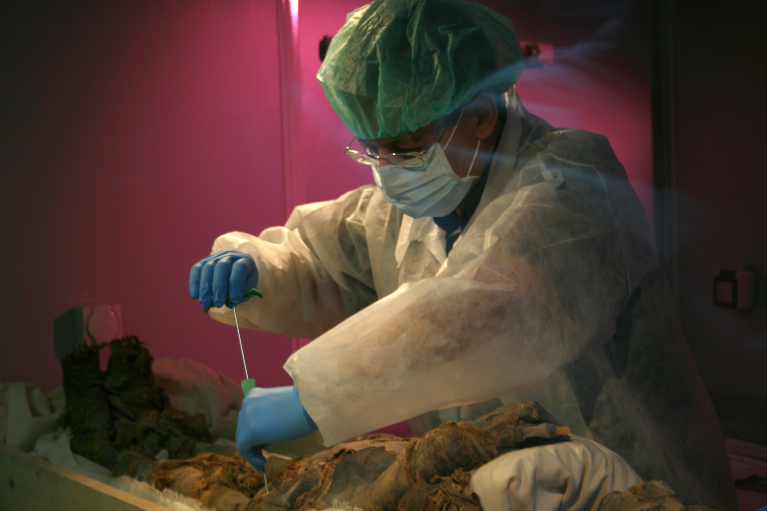
Yehia Gad takes a sample from a royal mummy for genetic sequencing.Credit: Yehia Z. Gad
Research has unveiled the genetic composition of an ancient Egyptian who lived around 4,500 years ago, revealing he had both North African and Iraqi ancestry in his DNA. The ongoing National Egyptian Genome Project is set to reveal more secrets from the past.
Over its 5,000-year history, Egypt has been a melting pot for the various ethnic groups that have made it their home.
“Modern-day Egyptians are a very diverse group because most genetic groups, with the exception of south-east Asians, have blended and merged with us throughout our history, be it as refugees, conquerors, or migrants,” explains Yehia Gad, a professor of molecular genetics and the scientific supervisor of the ancient DNA lab at the National Museum of Egyptian Civilisation (NMEC), a key partner of the Egyptian Genome Project1.
Genomic studies have shown that ancient Egyptians carried roughly 80% North African and 20% West Asian ancestry. Modern Egyptians display further admixture from Europe and sub‑Saharan Africa, placing them closer than many populations to a global genetic average, especially relative to groups with more regionally isolated ancestry2.
Despite this, North African populations are not adequately represented in genetic data sets, upon which many disease studies are based. A 2020 study showed that genetic differences between Egyptians and Europeans may compromise the transferability of European ancestry-based genetic disease risk and polygenic scores, further highlighting the importance of multi-ethnic genome references like that of Egypt3.
“The Egyptian Genome Project aims to fill this gap and better address the underrepresentation of Africans in genomic data,” says Gad.
The Egyptian Genome Project was launched in 2021 through a national coalition of various entities led by the Egyptian Center for Research and Regenerative Medicine (ECRRM). It aims to build an Egyptian Genomic Reference Database and train a new generation of geneticists on using the state-of-art equipment acquired for the project. It has four distinct genomic study groups; ancient, diseases, population and sports genomes, andwill sequence the genes of 100,000 Egyptians and 200 mummies.
Khaled Amer, principal investigator of the Egyptian Genome Project and the former CEO of ECRRM, explains that the first national biobank is already established, and has so far collected more than 3,000 samples and performed whole genomic sequencing (WGS) on more than 1,870 of them. Researchers have also recruited 1,152 samples from 372 families to analyse individuals and families affected by rare genetic conditions and are also currently sequencing 22 mummies.
The findings from the remains of a man who lived between 2855–2570 BC were published in Nature4 in July. It was the first time that researchers had successfully conducted a complete genetic sequencing of an Egyptian from this period, and it gave them rich findings into his ancestry.
“A fairly large sample size of this individual’s genetic ancestors was accessible in his genome,” says co-corresponding author and co-supervisor of the paper, Linus Girdland-Flink, of the University of Aberdeen. The Nature study revealed that the man’s ancestry was mostly North African, but that 20% of his genetic ancestry traced back to modern-day Iraq and surrounding regions, suggesting migration between Egypt and the eastern Fertile Crescent. He is predicted to have had brown eyes, brown hair and dark skin. The patterns of osteoarthritis and stress in his bones indicate that he might have been a potter.
Researchers believe that if one individual could provide that data, the 200 mummies the Egyptian Genome Project aims to analyse would add significantly to our understanding of the ancient world.
“We show that it’s likely that there is regional or local genetic continuity,” adds Girdland-Flink. Their paper stressed that the lack of similar genetic studies “remains a barrier to our understanding of population continuity and gene flow in the region.”
Co-corresponding author, Adeline Morez Jacobs, adds that ancient genomes help us better understand the evolutionary past, including that of disease and our bodies’ response to it.
“We are the outcome of the interaction between our genome and the environment, so studying the journey of the human race on Earth is important to understanding our present,” Gad says.
This, however, does come with various challenges. After a person’s death, enzymes break down the DNA and make it harder to analyse. The remains can also be polluted from those who have handled it throughout the years, microbes and embalming materials used. And scientists cannot freely extract samples from historically important remains like royal mummies, especially from the skull region where DNA is better preserved.
The sampling, DNA extraction and sequencing techniques are crucial in circumventing some of these challenges. Girdland-Flink adds that the field of ancient DNA has collectively accumulated knowledge on how to more precisely sample an ancient skeleton to maximise the chances of getting DNA. He hopes to collaborate with the Egyptian Genome Project to exchange that knowledge.
The diseases arm of the Egyptian Genome Project looks into genetic variants associated with cancer, common, infectious and rare diseases in the Egyptian population. It aims to establish personalised medicine and precision medicine, a goal Amer explains is crucial to the project and to developing accurate and effective treatment specifically for the needs of the population.
